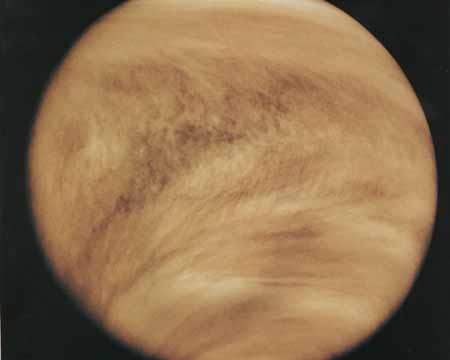At first glance, if Earth had a twin,
it would be Venus. The two planets are similar in size, mass, composition,
and distance from the Sun. But there the similarities end. Venus has no
ocean. Venus is covered by thick, rapidly spinning clouds that trap surface
heat, creating a scorched greenhouse-like world with temperatures hot enough
to melt lead and pressure so intense that standing on Venus would feel
like the pressure felt 900 meters deep in Earth's oceans. These clouds
reflect sunlight in addition to trapping heat. Because Venus reflects so
much sunlight, it is usually the brightest planet in the sky.
VENUS
Venus is the second planet from the Sun,
located in between Mercury and Earth. The orbit, or path, Venus follows
around the Sun is nearly circular, so the planet's distance from the Sun
averages about 65 million miles. Being closer to the Sun, a Venusian year,
the time it takes for it to complete a trip around the Sun, is just 225
days. Venus spins more slowly than Earth, though, so a day on Venus,
the time it takes for the planet
to turn once, is 243 days, which means that a day on Venus is longer than
it's year! Even more strange is the fact that Venus rotates from East to
West, which is just the opposite of Earth and most of the other planets.
Can I See It?
Yes, you
can see Venus for several months each year, either in the morning or evening
sky, and you don't need a telescope. Venus is called both the morning and
evening star, and ancient astronomers thought it was two different objects.
When it is visible, Venus is the second-brightest object in the sky,
being outshone only by the Moon. You would never guess that something that
is so beautiful could be so unpleasant in reality . Since Venus is closer
to the Sun than we are here on Earth, you could see the planet going
through phases like our Moon does if you have a telescope.
Be sure to check to sky maps here at Astronomy for Kids. If Venus is going
to be visible during a month, we will tell you where
and when
to see it.
How Big Is
It?
Venus is
almost the same size as Earth, with a diameter of a little over 7200 miles.
This is, thankfully, the only way that Venus is similar to Earth.
How Did It
Get Its Name?
Venus was
named for the goddess of love and beauty. This is definitely a case of
beauty being only skin deep, as Venus is a very unpleasant place, with
winds that blow hundreds of miles an hour, and temperatures that are hot
enough to melt most metals!
What Is It
Made Of?
Venus is
one of the solar system's rocky planets, along with Earth and Mercury.
The planet has an iron core, which is covered by a rocky layer. This
rocky layer has a lot of lava, which has been generated by the many volcanoes
on its surface.
What's It Like
on The Surface?
To put
it mildly, Venus is an extremely unpleasant place. The bright white light
that we see from Earth is a result of sunlight being reflected off the
clouds that completely cover the planets surface. These clouds are made
of sulfuric acid, which is an extremely dangerous substance. When you get
to the planet's surface, things get even worse. The temperature on Venus
averages around 900 degrees Fahrenheit, which is hot enough to melt
lead! That's not all, the clouds on Venus have created at atmosphere
that is
the same as being half a mile underwater here on Earth. The air pressure
would be enough to crush some submarines. Finally the winds on Venus are
almost always faster than a tornado, averaging around 240 miles per hour!
The few spacecraft that have managed to land on Venus have lasted less
than an hour before the heat and air pressure have melted and crushed
them.
For this
reason, a lot of what we know about the surface of Venus has come from
spacecraft that have studied the planet from a safe distance. We have also
been able to map some of the planet's surface using radar telescopes here
on Earth. What we have found is that Venus has a surface that has
many mountains (some higher than Mount Everest), volcanoes and plains filled
with lava.



